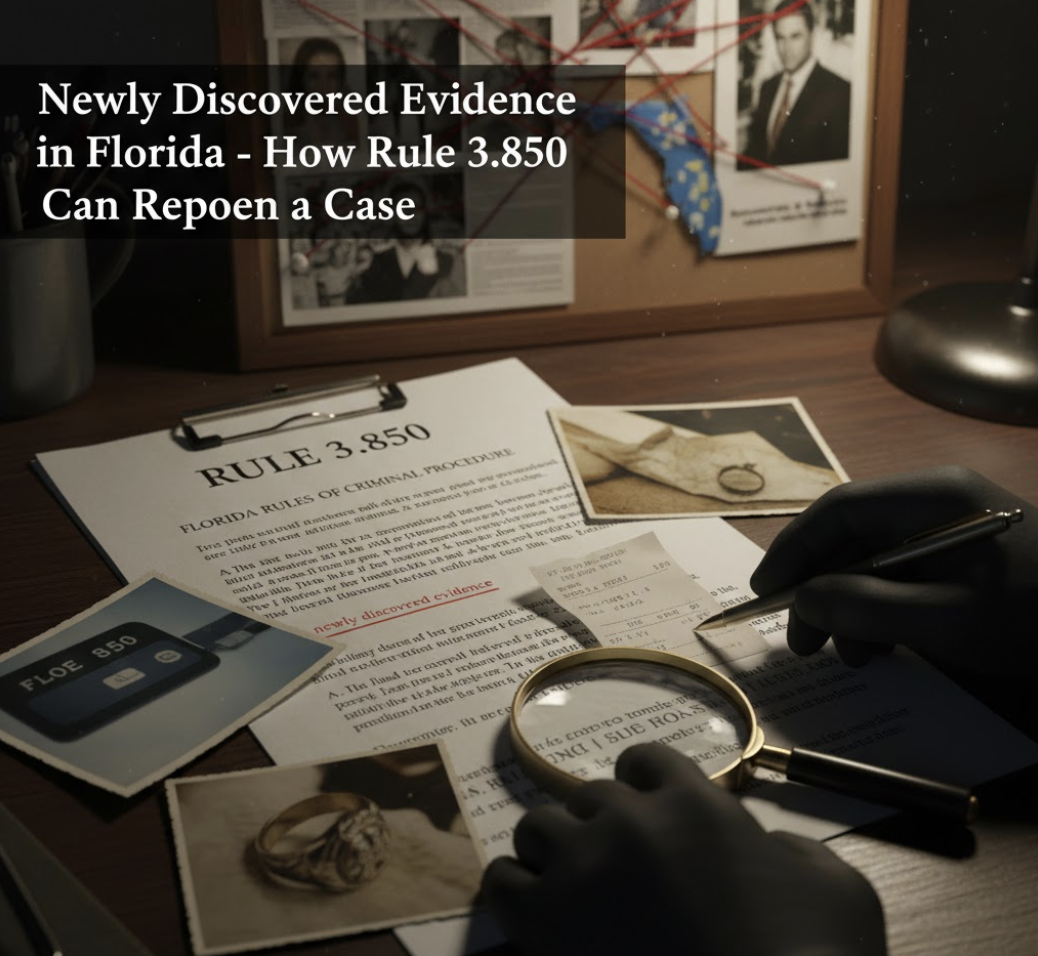
POST-CONVICTION RELIEF
Newly Discovered Evidence in Florida – How Rule 3.850 Can Reopen a Case
When truth surfaces late – a witness finally steps out of the shadows, a forensic lab revises an old conclusion, a co-defendant confesses – Florida law provides a disciplined path to relief. Florida Rule of Criminal Procedure 3.850 allows a conviction to be vacated when truly new evidence emerges and the defense acted diligently. This article distills the law, the deadlines, and the strategy – with real Florida cases – so you can see what a winning newly discovered evidence motion looks like.
The Legal Standard – What you must prove
Florida’s standard is twofold:
-
The evidence was unknown and could not have been found earlier through due diligence.
-
The new evidence is powerful enough that it would probably produce an acquittal at a new trial (or if the case originally resolved with a plea – if it had been available at the time, would likely have resulted in the person choosing to go to trial rather than accept a plea).
The Florida Supreme Court put it this way: newly discovered evidence warrants relief if it “would probably produce an acquittal on retrial.” See Jones v. State (1991).
The Court later emphasized that trial judges must consider all newly discovered evidence that would be admissible and then evaluate the weight of both the new and the original trial evidence in deciding whether a new trial is warranted. See Jones v. State (1998).
The Clock – Your deadline is tied to discovery, not the verdict
For noncapital cases, a newly discovered evidence claim is timely if filed within 2 years of when the new facts were or could have been discovered with due diligence. The text of Rule 3.850(b)(1) says exactly that.
Capital cases (e.g., First Degree Murder) are handled under Rule 3.851, which uses a one‑year period from discoverability – Florida decisions routinely measure timeliness from when the claim became discoverable through due diligence, a construction applied across rules with parallel language. See e.g., Jimenez v. State (2008).
Bottom line: do not wait. The clock runs from when the evidence could reasonably have been unearthed, not from the day of trial or appeal.
What counts as “newly discovered” – substance and diligence
Florida focuses on whether admissible proof of the facts was unavailable despite diligence – not on whether a defendant personally “knew what happened.” When a witness could not be located despite real efforts and emerges later with material testimony, Florida’s high court has held that this can be “sufficient to warrant an evidentiary hearing.” See Swafford v. State (1996).
By contrast, if the witness was known and accessible all along and only later voluntarily “decided to come forward,” that change of heart may not be considered newly discovered evidence. In Nordelo, the Third DCA affirmed denial where a co‑defendant was known and available at the time of trial – the later affidavit was not “new” just because the witness finally chose to speak. The court quoted the trial court’s observation that a witness’s post‑hoc willingness “does not render the evidence newly discoverable.”
Evidentiary hearings – credibility gets tested in court, not on paper
If your motion is facially sufficient and the new evidence turns on credibility or diligence, Florida courts generally require a live evidentiary hearing rather than a paper denial. The Supreme Court’s McLin decision and subsequent appellate decisions underscore that summary denial is “rarely appropriate” when the trial court must assess a new witness’s credibility.
The Supreme Court has also directed trial courts to analyze the cumulative impact of new evidence alongside any Brady material, not in isolation. In Gunsby, the Court recognized the cumulative effect of newly discovered evidence and suppressed evidence can warrant relief.
Types of newly discovered evidence we most often litigate
-
A vanished eyewitness reappears with testimony that aligns with the defense theory and could not be obtained earlier despite diligent attempts – classic Swafford territory for a hearing.
-
A co‑defendant confession or affidavit. Powerful if the person was truly unavailable before; weak if the person was known and reachable but simply refused to cooperate. see Nordelo.
-
Recantations. Florida courts treat recantations with skepticism – “recanting testimony is exceedingly unreliable” – and will grant relief only if the recantation is credible and would likely change the outcome after a hearing. see Armstrong.
-
New or improved science. Advances in DNA, digital forensics, gunshot residue methods, or cell‑site analysis can be newly discovered if the methodology or results were previously unavailable and are outcome‑determinative.
-
Withheld evidence revealed later (Brady) that, when combined with the new material, undermines confidence in the verdict – the cumulative analysis in Gunsby is instructive.
Evidence vs. awareness – a crucial distinction
Prosecutors often argue “the defendant was there – so he ‘knew’ these facts all along.” Florida law looks past that superficial claim. The question is whether admissible proof of those facts was obtainable despite diligence. If the only person who could prove what really happened had disappeared or refused to reveal her whereabouts, the defense is not punished for failing to do the impossible. That is exactly why Swafford ordered a hearing based on a later‑found witness affidavit and directed the trial court to test both due diligence and impact.
Procedure and packaging – how to file it right
-
Affidavits matter. As of October 1, 2025, the published rule text requires attaching an affidavit from a recanting witness or newly discovered witness – and, for other newly discovered evidence claims, an affidavit from any person whose testimony is necessary to support the claim – or a detailed explanation why it could not be obtained. Meticulous compliance strengthens credibility and avoids summary denial.
-
Make the diligence record. Document searches, subpoenas, skip‑tracing, public‑records requests, and investigator efforts. The due‑diligence prong is won on details.
-
Address materiality under Jones. Explain why the new evidence would probably produce an acquittal at a retrial, and – as the Supreme Court requires – weigh it against the trial record you are challenging.
- File within the window. In noncapital cases, file within two years of when the facts were or could have been discovered by diligence. Do not assume the clock starts at trial – it starts at discoverability.
FAQs
Does a sworn affidavit automatically win a new trial?
No. A solid affidavit often earns you the hearing – especially where credibility is at issue – but you still must prove diligence and that the new evidence would probably produce an acquittal.
What if my new witness is a co‑defendant who was always known but refused to testify?
Courts may treat that as not “newly discovered” – mere willingness to speak later is not enough. Nordelo is the cautionary tale. Framing is everything – a good lawyer will know how to make the argument to a Judge.
What if my case also has suppressed evidence?
Then the court must analyze the cumulative effect of all new and suppressed material. Gunsby shows how that combined weight can justify relief.
Strategic takeaways
-
Act immediately when a witness surfaces or a lab issues new findings; your deadline is tied to discoverability.
-
Build an impeccable diligence record – judges reward thorough investigation, not hindsight rhetoric.
-
Aim for the hearing by presenting a facially sufficient motion with sworn support – credibility belongs in the courtroom, not on the pleadings
- Frame materiality with precision – show exactly how the new evidence, weighed with the trial record, moves the needle to “probable acquittal” or if the case originally plead out, would likely have resulted in the defendant choosing trial as opposed to accepting a plea offer.
Non-exhaustive list of representative Florida authorities
-
Jones v. State (1991) – establishes the two‑prong test and the “probably produce an acquittal on retrial” standard.
-
Jones v. State (1998) – requires courts to consider all admissible newly discovered evidence and weigh it against the trial record.
-
Swafford v. State – later‑found witness affidavit warranted an evidentiary hearing, with due‑diligence and timeliness to be tested on remand.
-
Nordelo v. State – a known, available co‑defendant’s late affidavit is not “newly discovered” simply because he finally decided to talk.
-
McLin v. State – credibility disputes typically require an evidentiary hearing; summary denial is disfavored where live testimony is needed.
-
State v. Gunsby – courts must consider the cumulative effect of newly discovered evidence with any Brady material.
-
Armstrong v. State – recantations are “exceedingly unreliable” and require rigorous credibility testing before relief is granted.
-
Fla. R. Crim. P. 3.850(b)(1) – 2‑year limitation from discoverability; attaches to when facts were or could have been found with diligence.
If new proof of innocence exists, we know how to surface it
When a case hinges on a missing witness, a suppressed report, or a belated scientific finding, the law gives you a runway – but not for long, and not for sloppy work. Attorneys Kenneth and Joshua Padowitz build Rule 3.850 motions the way they must be built: sworn affidavits, granular diligence, and a disciplined Jones analysis that shows exactly why the jury would likely acquit.
If you, a family member, or a colleague believes material evidence has surfaced, contact our office for a confidential assessment. The sooner we move, the stronger your position under Florida’s newly discovered evidence framework.


